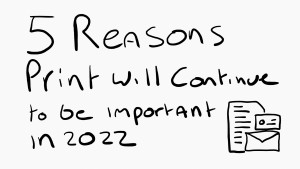
It’s easy to dismiss print media in today’s digital environment and focus entirely on Social Media, PPC, website optimization, and other online media. Print, on the other hand, is still alive and well and possibly more relevant and potent than ever before in the digital era.
Consumers are inundated with advertisements, emails, and internet material, making it difficult to reach the correct target. Print media plays a role in this. Print has resisted extinction for decades, and for good reason, It’s effective. Direct mail has a 37 percent greater response rate than email marketing, and young people inherently trust print content more than digital information (somewhat surprisingly).
Let’s look at some of the reasons why you should invest in print media in 2022.
1) Print Can Be Trusted
Print media is far more trusted by all groups, especially millennials, than any other content they are exposed to, according to research. Print media outperforms television, radio, and digital content, with printed newspapers being deemed more reliable than their online counterparts.
What is the explanation for this? Printed media is typically thought to be less intrusive, as there are no bothersome pop-up adverts to get in the way. A casual type of marketing is a brochure, magazine, or other form of print. The consumer may view the material whenever they want, without having an ad interrupt their Facebook stream. When it comes to picking a supplier, a customer’s trust is crucial.
Make sure you incorporate print in your marketing because it is the most reliable kind of media available.
2) Print Assists You In Reaching Your Target Market
Print can help you engage with the correct target group at the right moment, whether it’s a bespoke brochure, targeted Point of Sale material, or an exhibition stand. Younger generations are beginning to ‘unplug’ from their screens, and they are becoming the largest print media consumers. The attention of both young and old shoppers will be drawn to well-placed and well-designed in-store display units. Attention will be drawn to a billboard that boldly displays your new offering.
You may utilise print to target the correct audience at the right moment when you combine it with more data about purchasing behaviour. Adopting this multi-channel strategy at numerous touchpoints can help you convert at a higher rate, as it takes on average 12 engagements with a brand before a purchase.
3) Print Is Real
Nothing compares to holding a real well-designed brochure. A giant poster in a store or restaurant window offering a special offer will draw customers and diners in. Seeing and feeling is believing, and these products may be left in windows and on office desks for weeks or months at a time, delivering good value for money when compared to other media with a shorter lifespan.
4) Print Is Interesting
Print may be consumed in an easy-to-read style, enhancing the consumer’s experience and positively representing the business. Print allows you to successfully tell a good story, which aids sales pitches and other marketing activities.
A prospect is more likely to remember your print information if they read it. According to studies, we recall knowledge better when we read it in print than when we read it online. What is the explanation for this? Because print is physical and has an impact, it is easier for the brain to digest, resulting in increased recall.
5) Print Increases ROI
It’s no wonder that print has a high Return on Investment because it’s more engaging. For example, point-of-purchase and point-of-sale material reaches customers right when they’re ready to spend money.
A well-targeted direct mail campaign can attract an audience that is likely to open the mail and be interested in your product or service. Because the ad is real, it’s also easy to spread, so even if the initial customer isn’t interested, they can just pass the print on to someone who is!
